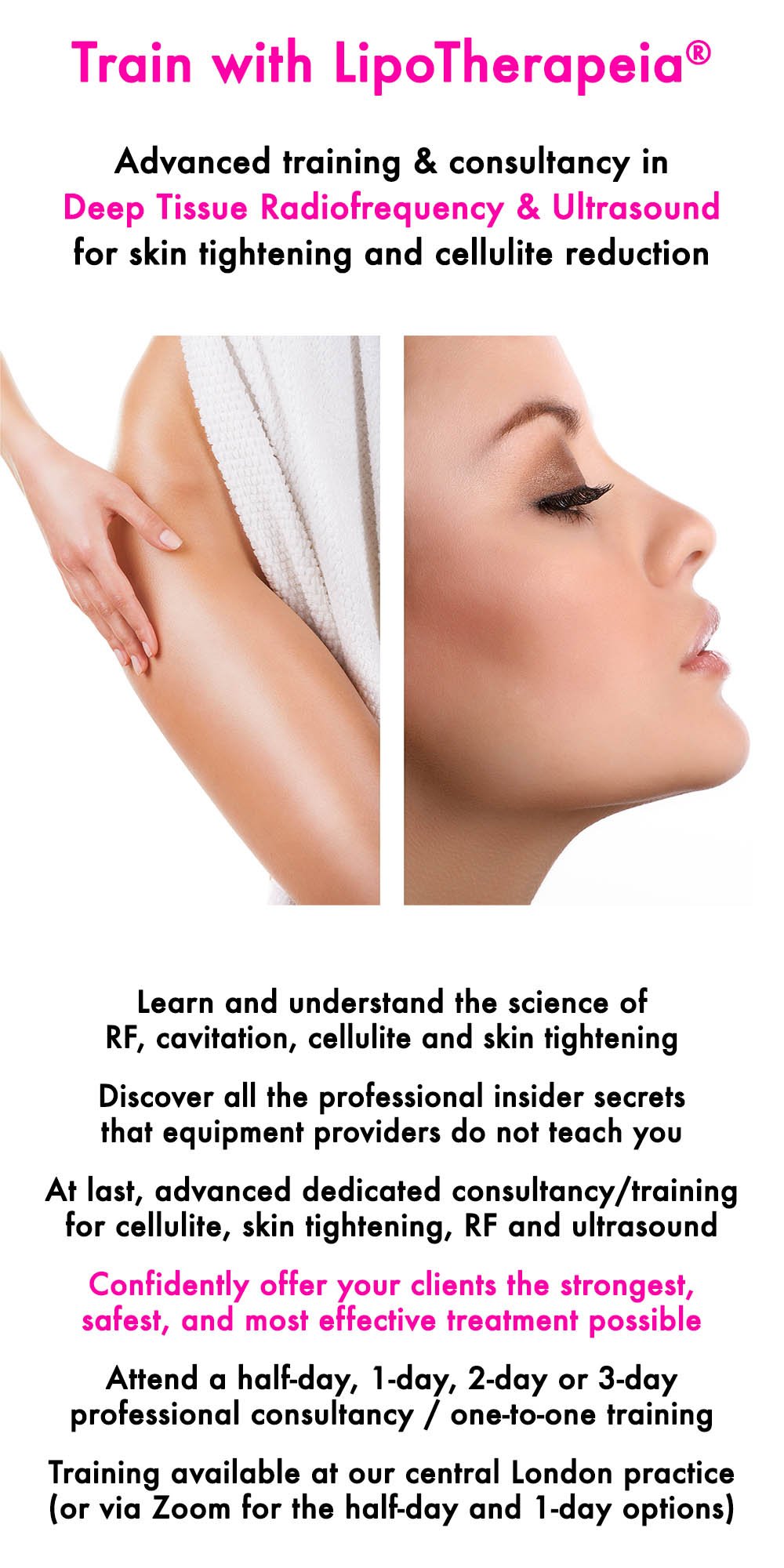Is RF treatment safe?
As with all treatments, medical, aesthetic or complementary, there is a chance of adverse reactions (usually small) and safety can never be 100%.
Radiofrequency treatments can be anything from very safe to quite unsafe, depending on:
How trained, knowledgable and experienced the therapist is - standards vary wildly from clinic to clinic and therapist to therapist
How well the equipment is maintained - you would be amazed how many machines are not serviced, knocked about or held together with tape
The equipment / nature of treatment itself: some treatments are an invitation to adverse reactions (e.g. extreme intensity RF, statically applied RF, microneedling RF etc), unless applied very carefully. Usually treatments that claim spectacular results in a couple of sessions are generally not very safe, simply because they work by injuring the skin, not stimulating it.
99.5%+ safety with properly applied deep acting radiofrequency
Radiofrequency treatment is based on electrically heating the skin.
If the pain threshold rule is adhered, deep-acting, high-power radiofrequency provided in a continuous moving fashion, should be ~99.5% safe, or better.
The pain threshold rule is the gold standard safety and efficacy rule, proven over 50+ years in physiotherapy and aesthetics.
The pain threshold rule for radiofrequency treatments stipulates that:
power should be such the client does not feel any pain/burn
the applicator should move continuously
anaesthetic cream should NEVER be used
In contrast, static (non-moving), painful treatments provided with anaesthetic cream are inherently unsafe and produce a lot of adverse reactions.
If you consider a radiofrequency treatment which requires the use of anaesthetic cream, be aware that you are considering a risky procedure.
More on that later.
What are common reactions to properly applied radiofrequency?
So with properly applied, deep-acting, high-power radiofrequency (the most effective SAFE type of radiofrequency), there should normally not be anything more than:
the very occasional tiny, acne spot size burn (once in a 1,000 sessions or less often)
redness that disappears in 1-2 days (very rare; normally redness disappears in 45 minutes)
skin sensitivity that disappears in 1-7 days (rare; normally there is zero skin sensitivity)
a small, pea-sized “bump”, which is due to overheating and collagen overproduction at the dermal-hypodermal junction (very rare and typically disappears in 1-6 weeks)
…in 0.5% of the cases or less.
These are the only adverse reactions that should normally occur with properly applied RF, and this is all we saw at the clinic the last 12+ years.
Of course, nothing in the human body (and life in general) can be guaranteed 100%, including the safety rate of any treatment.
Furthermore, safety rate can vary widely, from clinic to clinic and from therapist to therapist, but this is the safety rate you should generally expect from radiofrequency provided by a well-trained responsible therapist: 99.5% or better.
(The safety rate at our clinic was 99.9% last year.)
So a quality high-power, deep tissue radiofrequency treatment can be deemed extremely safe, if provided with the correct protocols and by a well-trained therapist.
As responsibly applied radiofrequency works by stimulating the skin, not burning it, it requires 6-12 sessions for best results.
Radiofrequency provided above the pain threshold
We talked above about how deep-acting, high-power radiofrequency should have a very high safety rate, when applied competently and below the pain threshold.
With such treatment, the typical skin surface (epidermal) temperature is <43ºC. This corresponds to hypodermal (i.e. deep skin) temperatures of <47ºC.
However, in aesthetics (never in physiotherapy) there is another trend: to go way above the pain threshold, use anaesthetic cream to mask the intense pain (sometimes even anaesthetic injections are required for that) and raise hypodermal temperatures to 60-90ºC. These temperatures can only be achieved with static, stamp-like radiofrequency.
The idea is that cellulite fat cells will be damaged and the resulting scar tissue will make skin firmer, in one or two sessions.
However, it usually does not go according to plan, with all sorts of adverse reactions occurring, sometimes severe.
Plus results are not better than with deep-acting, high-power radiofrequency either (quite often there are zero results), despite all the pain, skin damage and expense (these treatments normally cost 3-10x more than safe radiofrequency.
What are examples of such radiofrequency treatment?
The latest example of this fad is microneedling / fractional radiofrequency, which became popular in the last 2-3 years.
Another example is the good old extreme intensity radiofrequency, which has been around for 20+ years.
Both types are provided in a static fashion and with anaesthetic cream/injections.
And both types are examples of RF which aim to literally burn the skin, not to stimulate it, in order for the provider to promise results in 1-3 sessions and charge 3-10x times more for treatment of a small body area.
The irony is that with this type of RF, 6-12 sessions are still needed (if adverse reactions do not occur in the meantime), not just 1-3. There is no significant or long-lasting cellulite reduction or skin tightening with 1-3 sessions, with any method of any kind, including surgery (especially not with surgery).
This is because the human body needs repeated stimulation to change, not internal (and sometimes even external) skin burns.
Such irresponsible radiofrequency treatments can be deemed very unsafe, as they aim to literally cauterise the deep layers of the skin in order to produce skin tightening / cellulite reduction.
Burns, scars, post-inflammatory hyperpigmentation, swelling, fibrosis, skin hardening, paper-thin skin, crepey skin and scar tissue bumps are common adverse reactions when you take risks with your skin for “fast” results.
The four types of radiofrequency and their safety rate
Extremely high intensity radiofrequency (with microneedling or without) provided above the pain threshold and with the applicator not moving in order to create hot spots, and which aims to burn/coagulate/cauterise, is inherently safe, even if provided by an experienced practitioner
Deep-acting, high-power radiofrequency, provided below the pain threshold and with the applicator continuously moving in order to avoid hot spots, and which aims to stimulate change, is very safe, if provided by a experienced practitioner
Superficially-acting RF may be unsafe, if provided above the pain threshold, which would necessitate the use of anaesthetic cream. Additionally it does not work for cellulite and skin tightening, simply because it does not reach the deep skin layers.
Low power RF may indeed be safe but does not work




![How to get rid of cellulite | 111 tips from the experts [2024 update]](https://images.squarespace-cdn.com/content/v1/5294cad9e4b009e918124a61/1582205124442-U31A5ECGNCG62VFPPJWJ/How+to+get+rid+of+cellulite+in+2020.jpg)


